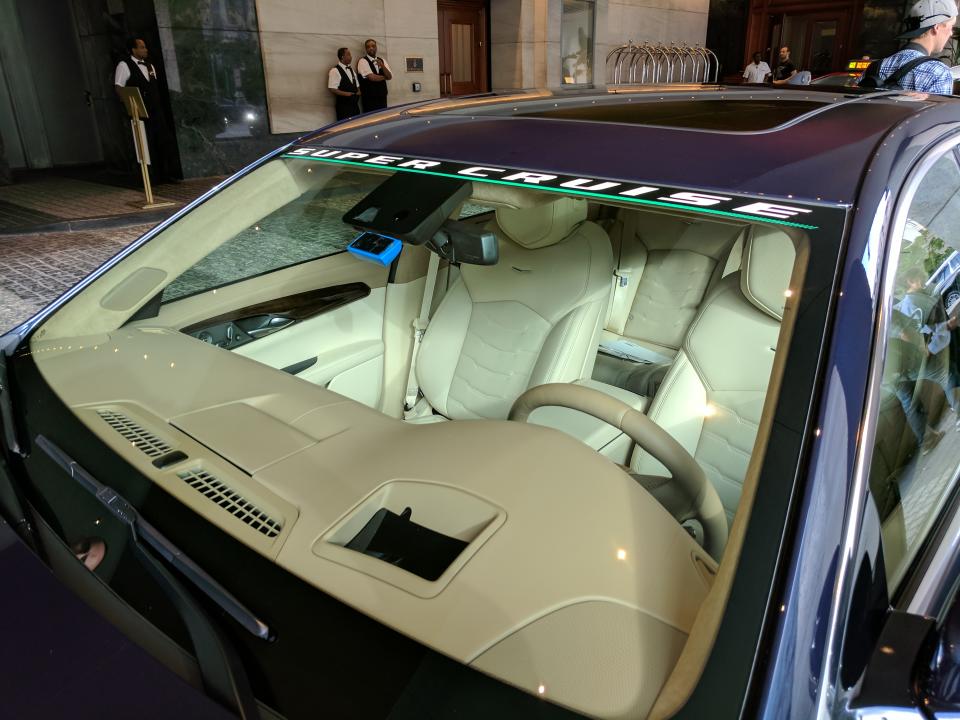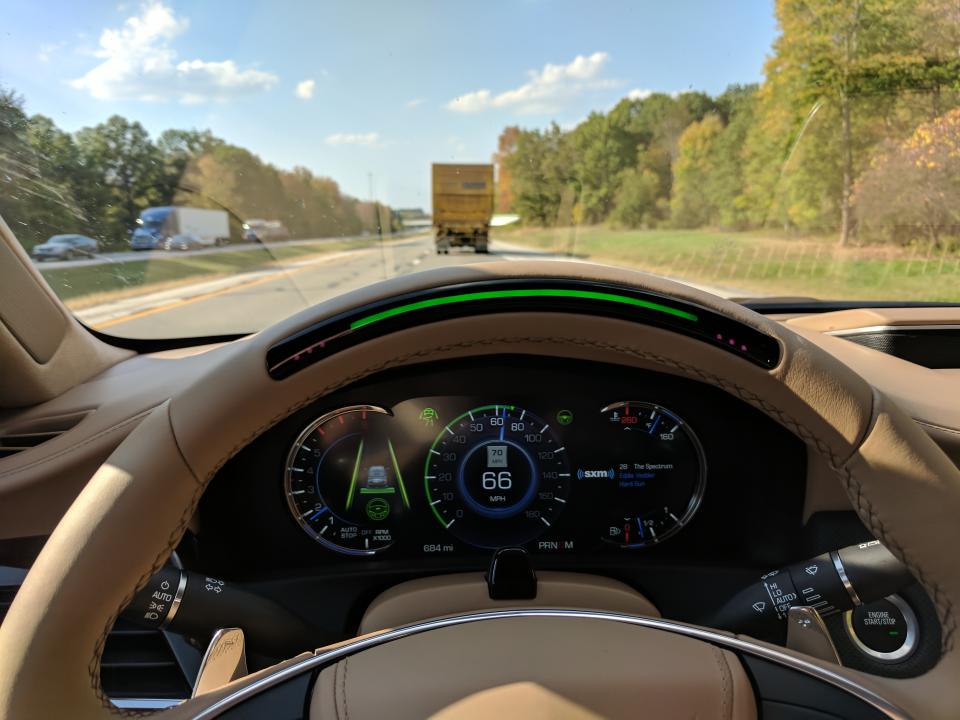What it's like riding in Cadillac’s self-driving Super Cruise for 350 miles

A new Cadillac drove me most of the way between Washington and Cleveland, and the car wouldn’t let me lose sight of that fact.
That roughly 376-mile road trip Tuesday in a pre-production 2018 CT6 sedan loaned by the GM (GM) subsidiary was my introduction to Super Cruise — Cadillac’s highways-only step into self-driving capability. Where everyday cruise control gives your foot a rest, Super Cruise liberates your hands. But not, as I quickly learned, your eyes.
The other hands-free mode
Here’s how it works: Once you’re on a controlled-access highway — with on- and off-ramps and oncoming traffic separated from your lanes, and which Cadillac has mapped — and you’ve engaged the usual cruise control, watch for a white steering-wheel icon to surface in the dashboard’s LCD screen.

When that indication of Super Cruise compatibility appears, you then press a button in the steering wheel to invoke the mode. After a few seconds, a light bar at the top of the wheel will illuminate in solid green — meaning you’re free to ignore every principle of safe driving and take your hands off the wheel.
The car will then keep itself centered in your lane with help from high-precision GPS, cameras to detect lane markings and radar to monitor other vehicles.
The CT6 ably dealt with slowing and merging traffic, and having the right lane closed off with orange cones didn’t faze it either. It only seemed confused for two brief moments: It jerked slightly to the right as we came off an overpass, then spent a few seconds hunting left and right in a stretch of road on which black squiggles of crack sealant obscured many lane markings.
Seeing the wheel turn unbidden was deeply weird. So was realizing how quickly I accepted the car driving me and trusted it not to sideswipe an 18-wheeler. I would have thought that 30 years of driving experience, much of it in a vehicle with a manual transmission, would have made me more reluctant to surrender control of a car.

But Super Cruise — included in the CT6’s $85,290 Platinum trim, a $5,000 option on its $66,290 Premium Luxury trim — won’t change lanes to pass a slower vehicle or move to the right to let a faster one pass. It treats the lane as a rail.
Pay attention, or else
wheeThe Super Cruise system’s cameras don’t just watch the road: One watches you to verify that you keep your eyes on the road, a feature that sets this apart from Tesla’s (TSLA) Autopilot.
If you don’t, that green bar in the steering wheel will start to blink. If you don’t then return your attention to the road, it will flash red and disengage Super Cruise. This happened repeatedly, especially early on as I took advantage of the car’s autonomous operation to take pictures and video.
The way this hands-free system wouldn’t let me take my eyes off the road led to some extended contemplation of the scenery ahead and the other cars — including mentally scolding the ones that had drifted out of a lane.

I found it particularly problematic with how long it took Super Cruise to re-engage. Waiting for the system to decide that conditions warranted automatic operation felt like trying to coax a genie to re-appear: Come back, Super Cruise! We need you!
As Interstate 70 became a surface street at Breezewood, Pa., I decided to test Super Cruise’s tolerance by not taking the wheel until I had to make a right turn through the Town of Motels to connect to the Pennsylvania Turnpike. The bar in the steering wheel went from flashing green to flashing red, and a synthesized voice barked an order: “Please take control of the vehicle!”
Then Super Cruise locked me out. This punishment continued until we stopped for lunch.
Had I ignored those last prompts, Super Cruise would have braked the car to stop, switched on the hazards and notified GM’s OnStar service of a potential medical emergency.
Will we need to reprogram drivers and laws?
I strongly favor self-driving cars. We humans are not as good at it as we imagine ourselves to be — something I was personally reminded of last month when a driver cut off my wife as she was biking to work, leading her to brake sharply, go over the handlebars and break her collarbone.
But while the partial autonomy Cadillac has chosen is easier to implement than fully autonomous modes that require expensive, bulky LIDAR sensors to detect pedestrians, it will only work if drivers don’t get too comfortable or cocky. That can work — commercial aviation involves long periods of planes flying themselves, interspersed by what pilots call “hand flying.” But the training and oversight pilots get far outstrip what any DMV would contemplate.
And as Cadillac warns in the manual, “Some state and local laws may require hands to be kept on the steering wheel at all times.”
A quick look at the laws of Maryland, Pennsylvania and Ohio suggests that theirs do not include that provision — not that I thought to check beforehand.
But I am told that another journalist taking part in this test drive got pulled over in the Keystone State anyway. He didn’t get a ticket, but he did have to spend some 20 minutes answering an intensely curious officer’s questions about how Super Cruise works. Can you blame the cop for being so fascinated? No. He was looking at the future — or at least one company’s idea of it.
More from Rob:
Email Rob at rob@robpegoraro.com; follow him on Twitter at @robpegoraro.

 Yahoo Finance
Yahoo Finance 
